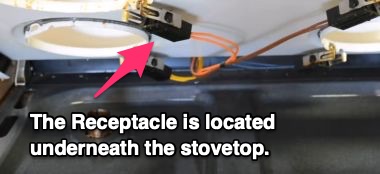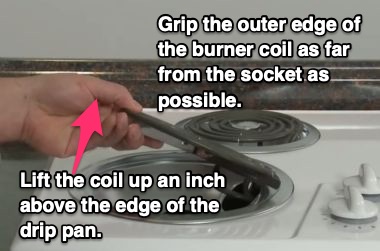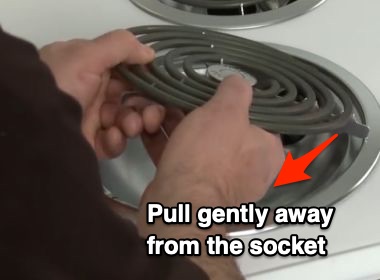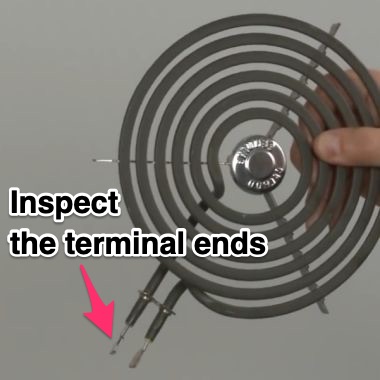When your electric stove burner isn’t working, your daily routine can be put on hold. Not only are you unable to cook, but you’ll also need to figure out what the problem is. Calling a professional can be quite expensive, especially if they have to diagnose the issue.
Before you take that route, try and figure out what the problem is yourself. By doing so, you just might save yourself a little cash. Even if you have little experience with home improvement repairs, the steps listed below are easy to perform. What do you have to lose?
Diagnosing your electric stove burner
Before you start diagnosing your electric stove burner, you should have a good understanding of how an electric burner circuit specifically works.
There are three main parts of the stovetop that typically tend to fail. They include the burner (1), the control switch (2), and the receptacle block (3). When your stovetop isn’t working, it’s usually one of these issues.

Stoves are built with at least two 120 volts of AC power. This is what’s are needed to heat up a stovetop burner fully. Inside the control switch, there are three contacts that close when you turn the nob to turn on your unit.
One contact sends 120 volts of AC to the indicator light after it closes, and the other two contacts send two legs of 120 volts to the receptacle block and then the burner allowing it to heat up fully.
The control switch allows us to control the heat. It does this by cycling on and off. For higher temperatures, the control switch cycles one of the legs running 120 volts to the receptacle block at a faster rate, and for lower temperatures, the control switch cycles at a slower pace. This is how the temperature is controlled.
Now that you know how an electric stovetop burner works, we can start diagnosing the issue and fixing the problem. If your stove won’t turn on at all, start by removing the burner from your stovetop. If you don’t know how to do this, simply follow the steps listed below:
☆ Make sure all the burners are off, and if they were on, make sure they’re fully cooled. You should also ensure that the electricity supply is turned OFF.
☆ Locate the receptacle, also known as a socket, that the faulty burner is plugged into.


☆ Raise the coil up about an inch above the drip pan that’s located below.

☆ Carefully pull the burner from the socket. You can move it back and forth until it releases.
☆ Carefully remove the tripod if one is present.
Once the burner is removed, inspect the receptacle. This is what the burner was plugged into before you removed it. Look for rust, corrosion, or signs of wear and tear. If you don’t see anything, try and plug the burner back into the receptacle block and see if it works.
Sometimes when the burner isn’t working, it’s simply because it wasn’t inserted all the way into the socket. This can happen if the stove or the burner itself was accidentally bumped into or wiggled out of place.
If your burner is still not working, then you’ll want to put it through a little test. Remove the burner and swap it with burner with one of the other equal-sized burners on your stovetop. What you’re trying to do here is see if it’s the receptacle block or the burner’s conductors that’s faulty.
If the faulty burner doesn’t heat up in either of the locations, then you know it’s the burner’s conductors. In this case, the burner will need to be replaced. These can be purchased at most home improvement stores.
On the other hand, if the faulty burner does heat up, then you know there’s a broken connection inside either the receptacle, the contacts on the control switch are not closing like they’re supposed to, or there’s a broken connection someplace else in the wiring connecting all the different components.
In this situation, it’s best to hire a professional unless you’re experienced with this sort of thing.

Now, sometimes the burner will only partly heat up. What do you do in this situation? First, you’ll want to remove the faulty burner and inspect the terminal ends. What you want to look for is rust, corrosion, or other wear and tear.
It’s important to note that if the ends are blackened or even pitted, there’s a good chance the terminals in the receptacle block are also worn. In fact, one of the most common symptoms of a bad receptacle box is when your stovetop burner only warms up part of the way.
If this is the case, it’s advised to replace both the receptacle block and possibly the burner itself. You can try to clean up the terminal ends, but if that doesn’t work, then you’ll have to go ahead and replace it.
Lastly, if your electric stove burner is overheating or won’t turn off, the problem is more than likely the temperature setting on the control switch is faulty and the contacts are not opening up like they’re supposed to.
If this is the situation, the control switch will need to be completely replaced as soon as possible. A stovetop that won’t turn off or overheats can be a hazard.
- Is a Hot Water Heater In the Attic a Good or Bad Idea? - July 18, 2021
- Lawn Mower Starts Then Dies – Here’s the Fix! - June 21, 2021
- Can You Mix Pine-Sol and Bleach? - September 9, 2020
